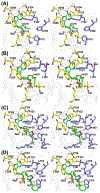Selective Inhibitors of Helicobacter pylori Methylthioadenosine Nucleosidase and Human Methylthioadenosine Phosphorylase
- PMID: 30860833
- PMCID: PMC6635953
- DOI: 10.1021/acs.jmedchem.8b01642
Selective Inhibitors of Helicobacter pylori Methylthioadenosine Nucleosidase and Human Methylthioadenosine Phosphorylase
Abstract
Bacterial 5'-methylthioadenosine/ S-adenosylhomocysteine nucleosidase (MTAN) hydrolyzes adenine from its substrates to form S-methyl-5-thioribose and S-ribosyl-l-homocysteine. MTANs are involved in quorum sensing, menaquinone synthesis, and 5'-methylthioadenosine recycling to S-adenosylmethionine. Helicobacter pylori uses MTAN in its unusual menaquinone pathway, making H. pylori MTAN a target for antibiotic development. Human 5'-methylthioadenosine phosphorylase (MTAP), a reported anticancer target, catalyzes phosphorolysis of 5'-methylthioadenosine to salvage S-adenosylmethionine. Transition-state analogues designed for HpMTAN and MTAP show significant overlap in specificity. Fifteen unique transition-state analogues are described here and are used to explore inhibitor specificity. Several analogues of HpMTAN bind in the picomolar range while inhibiting human MTAP with orders of magnitude weaker affinity. Structural analysis of HpMTAN shows inhibitors extending through a hydrophobic channel to the protein surface. The more enclosed catalytic sites of human MTAP require the inhibitors to adopt a folded structure, displacing the phosphate nucleophile from the catalytic site.
Conflict of interest statement
The authors declare no competing financial interest.
Figures









References
-
- Lieber CS; Packer L S-Adenosylmethionine: Molecular, Biological, and Clinical Aspects–an Introduction. Am. J. Clin. Nutr 2002, 76, 1148S–1150S. - PubMed
-
- Loenen WAM S-Adenosylmethionine: Jack of All Trades and Master of Everything? Biochem. Soc. Trans 2006, 34, 330–333. - PubMed
-
- Tabor CW; Tabor H Polyamines. Annu. Rev. Biochem 1984, 53, 749–790. - PubMed
-
- Basu I; Cordovano G; Das I; Belbin TJ; Guha C; Schramm VL A Transition State Analogue of 5′-Methylthioadeno-sine Phosphorylase Induces Apoptosis in Head and Neck Cancers. J. Biol. Chem 2007, 282, 21477–21486. - PubMed
Publication types
MeSH terms
Substances
Grants and funding
LinkOut - more resources
Full Text Sources
Chemical Information

